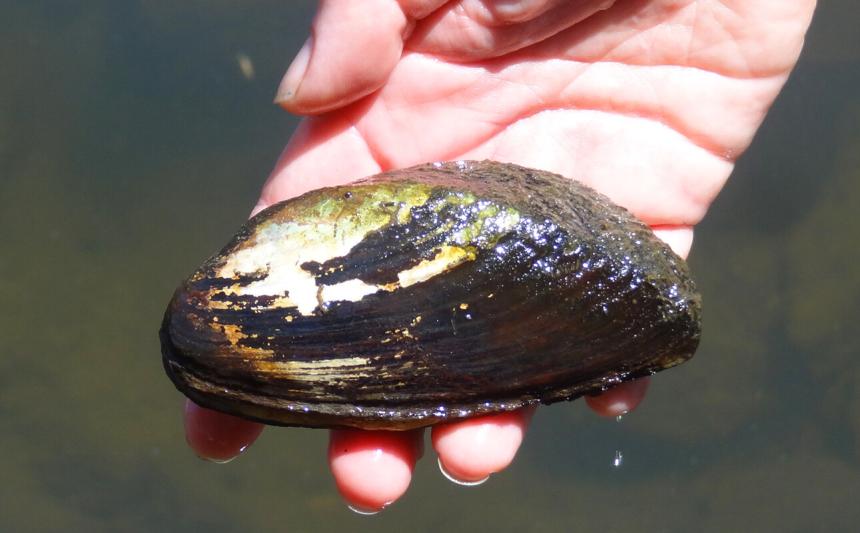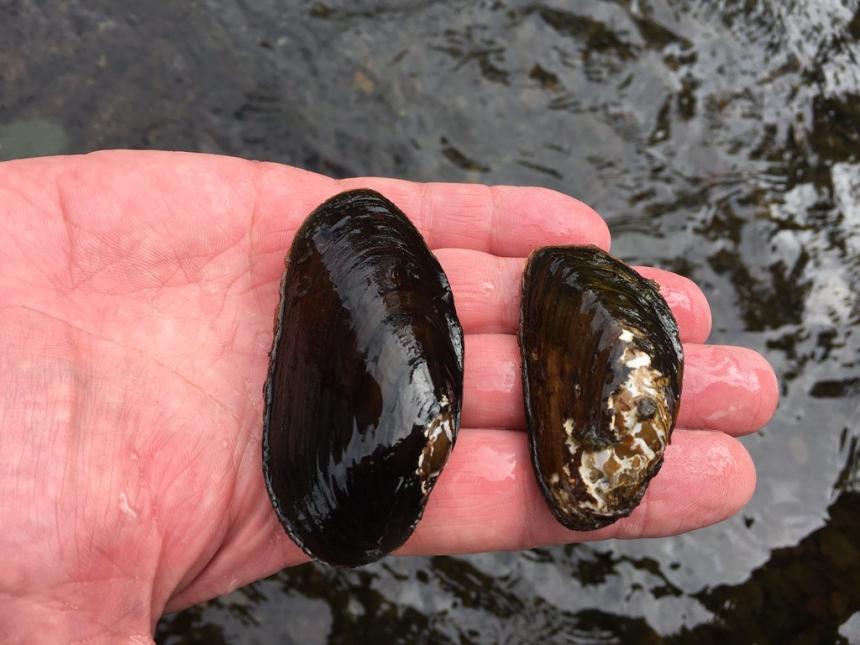Moderate
In Washington, the western ridged mussel is uncommon, and its population size is declining or extinct in parts of its range due to habitat alteration and pollution. Declines or extirpations have been reported in the Little Spokane, Wenatchee, and Yakima Rivers. The western ridged mussel is long-lived, sedentary, and sensitive to environmental change, so it is considered an excellent indicator of water quality.
Freshwater mussels have been greatly affected by dams and annual water drawdowns, as well as degraded water quality resulting from development and agriculture. Many historical sites no longer support mussels, and many local populations no longer successfully reproduce.
Description and Range
Physical description
Western ridged mussel is a bivalved freshwater mollusk. It is the only species in the genus Gonidea. They are up to 5 inches long. They have a trapizoidal shaped shell or it may be wider in the middle (obovate). An upraised ridge runs along the top of the shell. Their shell may be yellowish brown, brown or black. For more details (including photos), see the Xerces Society’s guide to Freshwater Mussels of the Pacific Northwest (PDF).
Ecology and life history
Freshwater mussels are found in shallow habitats in permanent bodies of water, including creeks, rivers, and ponds generally at low elevations. Mussels tend to concentrate in areas of streams with consistent flows and stable substrate conditions. They are often absent or sparse in high-gradient, rocky rivers, but are frequently encountered in low-gradient creeks and rivers, perhaps because they provide a variety of habitat conditions, reliable flow, good water quality, and diverse fish communities. The mussels are filter feeders that consume phytoplankton and zooplankton suspended in the water.
Western ridged mussels inhabit the bottom of cold creeks, rivers, and lakes from low to mid-elevations with substrates that vary from gravel to firm mud, and include at least some sand, silt or clay. It is generally associated with constant flow, shallow water (less than 10 feet in depth), and well-oxygenated substrates. This species is often present in seasonally turbid streams, but it is absent from continuously turbid water (such as glacial meltwater streams).
Freshwater mussels have a complex life cycle. They have separate sexes. During breeding, males release sperm into the water and females filter it from the water for fertilization to occur. Embryos develop into larvae called glochidia, which are released into the water and must encounter and attach to a fin or gill filaments of host fish. Glochidia form a cyst around themselves and remain on a host for several weeks. They subsequently release from the host fish and sink to the bottom, burrow in the sediment and remain buried until they mature.
Like other freshwater mussels, western ridged mussels rely on host fishes to reproduce and disperse. Because freshwater mussels are not able to move far on their own, their association with fish allows them to colonize new areas or repopulate areas from which they have been extirpated. During their lives, mussels may move less than a few yards from the spot where they first landed after dropping from their host fish. The fish host species for western ridged mussels in Washington are unknown, but in northern California, hardhead (Mylopharodon conocephalus), pit sculpin (Cottus pitensis), and Tule perch (Hysterocarpus traski) are hosts these mussels.
Freshwater mussels that live in dense beds, including western pearlshell and western ridged mussels, provide an important water purification service; they can filter suspended solids, nutrients and contaminants from the water column and collectively improve water quality by reducing turbidity and controlling nutrient levels.
Western ridged mussels have an average life span of approximately 60 to 70 years, although some individuals are thought to have lived more than 100 years. Because this species is sedentary, sensitive to environmental changes, and long-lived, it can be an excellent biological indicator of water quality.
Geographic range
The western ridged mussel is widely distributed in Washington, Oregon, California, Idaho, Nevada, and southern British Columbia. This species is more common east of the Cascades of Oregon and Washington than on the western side. In Washington, the Western Ridged Mussel was known from the Columbia River (Kittitas County), Toppenish Creek (Yakima County), Yakima River (Benton County), the Snake River (Columbia County), Chehalis River (Grays Harbor, Lewis Counties), Skookumchuck River (Lewis County), Spokane River (Lincoln County), the Columbia, Okanagan, Similkameen, Spokane and Little Spokane Rivers, Osoyoos Lake, Palmer and Hangman Creeks, and Spokane Falls (Okanagan County), and Colville River (Stevens County). Declines or extirpations have been reported in the Little Spokane, Wenatchee, and Yakima Rivers.
For a map of range-wide distribution and conservation status of this species, check out Nature Serve Explorer.
Climate vulnerability
Sensitivity to climate change
Low-
Moderate
There is limited information regarding the sensitivity of the Western ridged mussel to climate change. This species is generally found in shallow pools of freshwater creeks and streams and with good water quality and a sufficient abundance of small fish (e.g., sculpin and perch) who serve as hosts for mussels during their transition from the larval to juvenile stage. Therefore, their main sensitivity is likely to stem from climate-induced changes in water quality and host fish abundance. For instance, increased intensity of winter storms could lead to higher flow in rivers and increased nutrient runoff, both of which would degrade and reduce available mussel habitat. Additionally, increases in water temperature could lead to altered abundance of host fish for larval stage mussels, thus triggering declines in abundance, particularly since this species appears to be a specialist in terms of preferred host fish species. Western ridged mussels may also be sensitive to increasing water temperature in streams and creeks; increased temperatures could lead to decreased recruitment and increased mortality of larval stage mussels.
Exposure to climate change
Moderate-
High
- Increased water temperatures
- Altered flow regimes
Regulations
Rules and seasons
For current rules about harvesting shellfish in Washington, be sure to check the statewide Shellfish/Seaweed Species Rules.
Conservation
Conservation Threats and Actions Needed
- Agriculture and aquaculture side effects
- Threat: Pollution; need information on life history and ecology.
- Action Needed: Protect water quality
- Resource information collection needs
- Threat: Need information on life history and ecology.
- Action Needed: Life history research.
See the Climate vulnerability section for information about the threats posed by climate change to this species.
Resources
References
Frest, T. J. and E. J. Johannes. 1995. Interior Columbia Basin mollusk species of special concern. Final report to the Interior Columbia Basin Ecosystem Management Project, Walla Walla, WA. Contract #43-0E00-4-9112. 274 pp. plus appendices.
Jepsen, S., C. LaBar,and J. Zarnoch. 2012. Profile: Western pearlshell (Margaritifera falcata). The Xerces Society. 24 pp.
Jepsen, S., C. LaBar,and J. Zarnoch. 2011. Profile: California floater (Anodonta californiensis) / Winged floater (Anodonta nuttalliana). The Xerces Society. 31 pp.
Jepsen, S., C. LaBar, and J. Zarnoch. 2011. Profile: Western ridged mussel (Gonidea angulata) .The Xerces Society. 19 pp.
Nedeau, E. J., A. K. Smith, J. Stione, and S. Jepsen. 2009. Freshwater Mussels of the Pacific Northwest. 2nd edition. The Xerces Society. 51pp.

